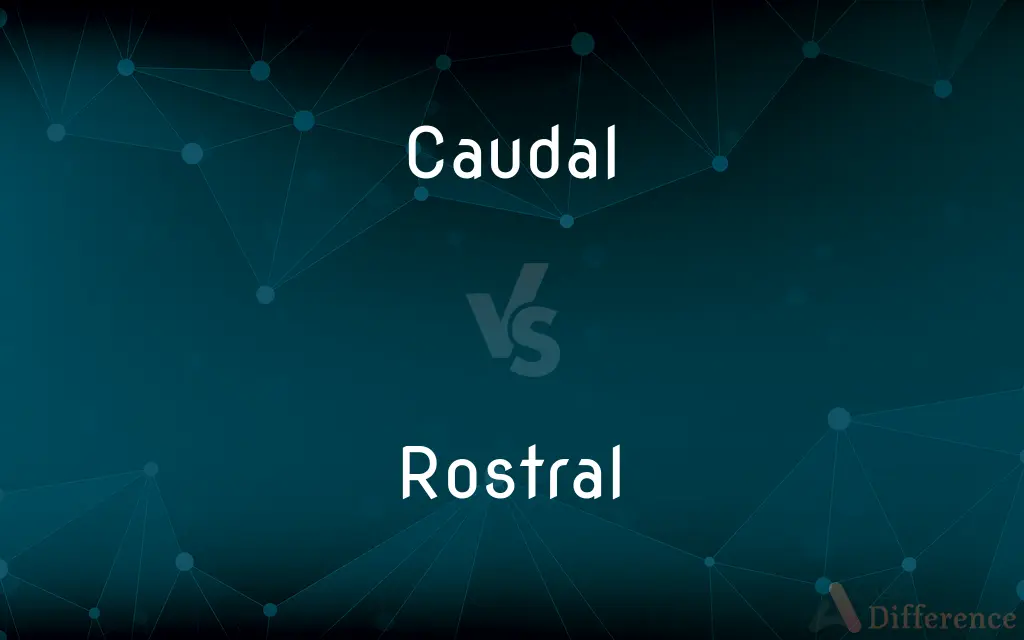Caudal vs. Rostral — What's the Difference?
By Urooj Arif & Maham Liaqat — Updated on March 17, 2024
Caudal refers to anatomical direction towards the tail or rear end of the body, while rostral points towards the head or front end, particularly in the context of the central nervous system.

Difference Between Caudal and Rostral
Table of Contents
ADVERTISEMENT
Key Differences
Caudal is a term used in anatomy to describe a position or direction towards the tail end of the body in animals, or the lower part of the body in humans. It is often used when discussing parts of the body or movements in relation to the spine. On the other hand, rostral is used to indicate direction towards the front or head, especially in the context of the brain or spinal cord, highlighting a forward or anterior orientation.
In the context of the central nervous system, caudal refers to positions or structures that are closer to the tail end of the spinal cord. This is particularly relevant in neuroanatomy, where precise spatial orientation is crucial. Rostral, in contrast, points towards the brain and is used to describe structures that are nearer to the nose or forehead, emphasizing an anterior position within the cranial aspect of the body.
When comparing vertebrates, the caudal direction helps in identifying features or sections of the body that are towards the rear, such as the caudal fin in fish. Rostral is less commonly used outside of the context of the head but serves a crucial role in distinguishing features towards the organism's front, especially in the study of brain regions.
In terms of anatomical planes, caudal is opposite to cranial (or cephalic), which also means towards the head but is used more generally for the whole body rather than focusing on the central nervous system. Meanwhile, rostral is specifically contrasted with caudal in discussions about the brain and spinal column, reinforcing the anteroposterior (front-back) orientation in neuroanatomy.
Understanding the difference between caudal and rostral is essential for medical professionals when describing lesions, surgical approaches, or neurological pathways. For example, a caudal block in anesthesia is directed towards the tailbone area to provide pain relief in lower limb surgeries, while rostral pathways in the brain might be studied in research on cognitive functions or neurological disorders.
ADVERTISEMENT
Comparison Chart
Direction
Towards the tail or lower body
Towards the head or front end
Context
General body orientation, spinal anatomy
Primarily central nervous system, brain orientation
Opposite Term
Cranial (towards the head)
Caudal (towards the tail)
Clinical Use
Descriptions of lower body regions, caudal anesthesia
Descriptions of brain regions, anterior surgical approaches
Relevance
Whole body orientation in vertebrates
Focused on brain and anterior spinal regions
Compare with Definitions
Caudal
In veterinary medicine, indicating the back of an animal.
The vet administered the injection in the caudal region of the dog.
Rostral
Directed towards the nose or forehead.
The rostral direction is crucial in brain surgery planning.
Caudal
Used to describe posterior anatomical directions.
The surgeon made a caudal incision below the waist.
Rostral
Pertaining to the front part of the brain.
The rostral prefrontal cortex is involved in complex cognitive functions.
Caudal
Directed towards the lower body or tail in humans.
Pain in the caudal spine can indicate lower back issues.
Rostral
Opposite of caudal when discussing brain orientation.
From a rostral to caudal perspective, brain development is highly orchestrated.
Caudal
Opposite of cranial in general anatomy.
Moving from the cranial to the caudal end of the vertebral column.
Rostral
Used to describe anterior aspects of the central nervous system.
The study focused on the rostral flow of cerebrospinal fluid.
Caudal
Relating to the tail or posterior part of the body.
The caudal fin propels the fish forward.
Rostral
In relation to the head or forward direction in anatomy.
Rostral displacement of bones is seen in some facial fractures.
Caudal
Of, at, or near the tail or hind parts; posterior
The caudal fin of a fish.
Rostral
(Anatomy) At, near, or toward the head, especially the front of the head
The rostral prefrontal cortex.
Caudal
Situated beneath or on the underside; inferior.
Rostral
Of or relating to a rostrum.
Caudal
Similar to a tail in form or function.
Rostral
(anatomy) Relating to the rostrum.
Caudal
(zoology) Pertaining to the tail or posterior or hind part of a body.
Rostral
Serving as a rostrum.
Rostral column
Caudal
Toward the tail end (hind end) of the body; in bipeds such as humans, this direction corresponds to inferior.
Rostral
A scale in reptiles on the median plate of the tip of the snout that borders the mouth opening.
Caudal
A caudal vertebra.
Rostral
Of or pertaining to the beak or snout of an animal, or the beak of a ship; resembling a rostrum, esp., the rostra at Rome, or their decorations.
[Monuments] adorned with rostral crowns and naval ornaments.
Caudal
Of the nature of, or pertaining to, a tail; having a tail-like appendage.
The male widow-bird, remarkable for his caudal plumes.
Caudal
Constituting or relating to a tail;
Caudal appendage
Caudal
Resembling a tail
Caudal
(of quadrupeds) situated in or directed toward the part of the body from which the tail arises;
Caudal fins
The caudal end of the body
Caudal
Toward the posterior end of the body
Common Curiosities
How is rostral used in neuroscience?
In neuroscience, rostral describes directions towards the front of the brain or anterior parts of the central nervous system.
What does caudal mean in medical terms?
In medical terms, caudal refers to directions or positions towards the tail or lower part of the body.
Can the terms caudal and rostral be used interchangeably with anterior and posterior?
While similar, caudal and rostral are more specific; caudal is similar to posterior (back), and rostral is similar to anterior (front), especially in the context of the head and central nervous system.
How do caudal and rostral directions aid in surgical planning?
They provide precise anatomical descriptions, helping surgeons navigate towards or away from critical structures.
What role do caudal and rostral directions play in animal anatomy studies?
These directions help in understanding the layout and function of animal bodies, essential for veterinary medicine and biological research.
How does the concept of caudal differ in bipeds and quadrupeds?
While the concept remains based on body orientation towards the tail, its practical application adjusts for the organism's posture and anatomy.
Can caudal and cranial directions be used to describe the same features?
Caudal and cranial directions describe opposite ends of the body, so they are used to contrast rather than describe the same features.
Why is understanding caudal and rostral important in anatomy?
Understanding these terms is crucial for accurately describing locations, orientations, and movements within the body, especially for medical and research purposes.
Do caudal and rostral apply to human anatomy only?
No, these terms apply to the anatomy of all vertebrates, though their specific use may vary depending on the organism's structure.
What is a caudal injection?
A caudal injection is an anesthesia technique targeting the caudal epidural space, often used in surgeries involving the lower body.
What anatomical features are associated with rostral structures?
Rostral structures are associated with the brain, such as the frontal lobes and anterior neural pathways.
Is the term rostral used outside of the central nervous system?
Primarily, rostral is used in reference to the brain and spinal cord, though it can occasionally apply to other anterior aspects of the body.
Are there any specific diseases associated with caudal or rostral parts of the body?
Diseases aren't classified as caudal or rostral, but these terms may describe the location of lesions or affected areas.
How do caudal and rostral directions facilitate communication among healthcare professionals?
They offer a standardized language for describing anatomical locations, enhancing clarity and reducing ambiguity in clinical settings.
Why are caudal and rostral important in neuroanatomy?
They enable precise localization and discussion of neural structures, pathways, and functions within the brain and spinal cord.
Share Your Discovery

Previous Comparison
Creative vs. Practical
Next Comparison
Quin vs. QuadAuthor Spotlight
Written by
Urooj ArifUrooj is a skilled content writer at Ask Difference, known for her exceptional ability to simplify complex topics into engaging and informative content. With a passion for research and a flair for clear, concise writing, she consistently delivers articles that resonate with our diverse audience.
Co-written by
Maham Liaqat













































